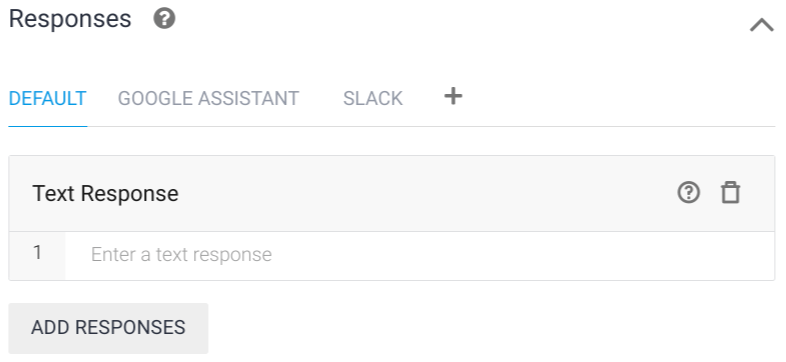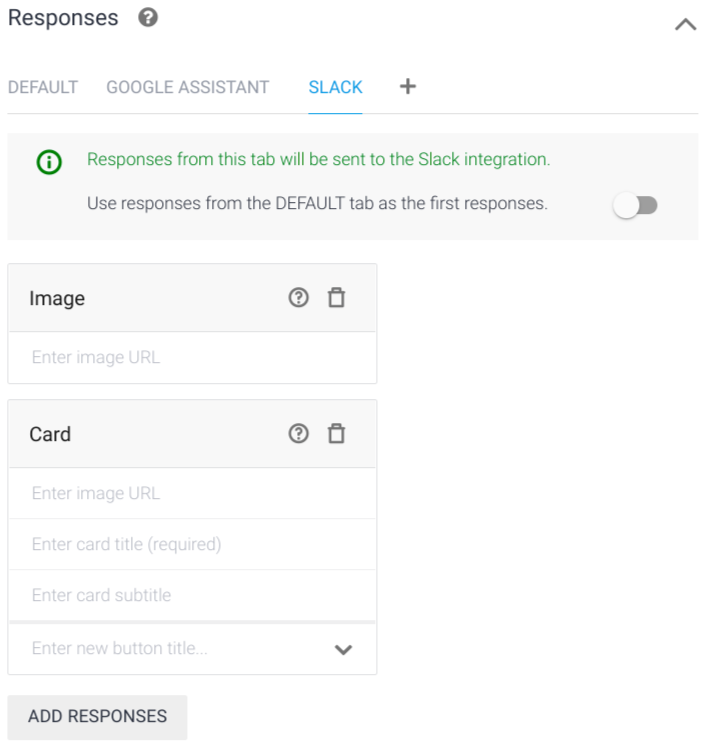许多集成平台都支持平台专属的富响应消息。这些消息可用于为最终用户提供比文本响应更丰富的内容。有多种响应类型可供选择。例如,您可以显示图片、播放音频或提供按钮。每个平台都支持部分可用响应类型。
如何查找此数据
构建代理时,最常见的方法是使用 Dialogflow ES 控制台(访问文档,打开控制台)。以下说明着重介绍如何使用控制台。如需访问意图响应数据,请执行以下操作:
- 前往 Dialogflow ES 控制台。
- 选择一个代理。
- 在左侧边栏菜单中选择意图 (Intents)。
- 选择一个意图。
- 向下滚动至响应部分。
如果您要使用 API 而非控制台来构建代理,请参阅意图参考。API 字段名称与控制台字段名称类似。以下说明重点介绍控制台与 API 之间的重要差异。
添加富响应消息
响应部分包含每个平台的标签页,包括默认平台。您可以为默认平台定义响应,这些响应可在所有平台上使用。

您可以为平台专属的标签页定义响应,这些响应仅适用于相应的平台。您还可以选择针对特定平台使用默认响应,这样您就不需要为所有平台创建重复的文本响应。

如需添加富响应消息,请执行以下操作:
- 选择所需平台的标签页。如果所需平台标签页未显示,请点击添加 add 按钮并选择该标签页。
- 点击添加响应按钮。下拉列表会显示该平台支持的响应类型。
- 选择响应类型。具体说明如下。
- 为所选响应类型输入各字段。
- 根据需要添加更多平台标签页和响应。每个标签页中最多可添加 10 条有序消息。
- 点击保存。
您可以在响应中使用参数引用来引用最终用户或事件在运行时提供的参数。
文本响应
默认情况下,文本响应会向最终用户发送文本响应。
如果为代理启用文字转语音功能或通过检测意图请求发出请求,则所提供的文字将用于合成语音并播放音频。在这种情况下,提供的文本可以选择使用语音合成标记语言 (SSML)。
字段包括:
- 文本或 SSML 条目列表
输入响应时,按 Shift + Enter 可输入换行符,或仅按 Enter 输入另一条文本响应。
存在以下限制:
- 每个文本相应最多包含 300 个文本条目
图片响应
图片响应会向最终用户发送图片。此类响应包含以下字段:
- 图片的可公开访问的网址
卡片响应
卡片响应会向最终用户发送图片、卡片标题、卡片副标题和交互式按钮。卡片的样式因平台而异。
您可以配置按钮,向最终用户发送网址或将预配置文本发送到 Dialogflow,就好像最终用户提供了表达式一样。
部分字段为可选字段,具体视平台而定:
- 图片的可公开访问的网址
- 卡片标题
- 卡片副标题
- 包含以下字段的按钮列表:
- 按钮标题
- 要作为最终用户表达式发送的文本或要打开的网址
存在以下限制:
针对每一个意图,每个平台和每种语言最多包含 10 张卡片。例如,如果您的代理支持英语、法语、平台 X 和平台 Y,则一个意图最多可以包含 40 张卡片:
- 10 张针对平台 X 的英语卡片
- 10 张针对平台 Y 的英语卡片
- 10 张针对平台 X 的法语卡片
- 10 张针对平台 Y 的法语卡片
快速回复响应
快速回复响应会向最终用户发送一个按钮。您可以配置按钮,将预配置文本发送到 Dialogflow,就好像最终用户提供了表达式一样。
字段包括:
- 按钮标题
- 作为最终用户表达式发送的文本条目列表
存在以下限制:
针对一个意图,每个平台和每种语言最多仅能设置一个快速回复响应。例如,如果您的代理支持英语、法语、平台 X 和平台 Y,则一个意图最多可以包含 4 个快速回复:
- 1 个针对平台 X 的英语快速回复
- 1 个针对平台 Y 的英语快速回复
- 1 个针对平台 X 的法语快速回复
- 1 个针对平台 Y 的法语快速回复
每个快速回复响应最多包含 10 个文本条目。
每个文本条目最多包含 20 个字符。
合成语音响应
合成语音响应用于基于文本响应的合成语音并播放音频。提供的文本可以选择使用语音合成标记语言 (SSML)。
字段包括:
- 文本或 SSML
存在以下限制:
- 仅由 Dialogflow Phone Gateway 集成支持
- 每个意图最多包含 20 个合成语音响应
播放音频响应
播放音频响应用于播放音频文件。在 Cloud Storage 存储分区中提供音频文件。
字段包括:
- Cloud Storage 对象 URI 采用
gs://bucket-name/object-name格式。
存在以下限制:
- 仅由 Dialogflow Phone Gateway 集成支持
- 音频文件规范:单声道 8kHz 的线性 PCM 音频(2 字节/采样)
- 每个意图最多播放 20 次音频响应
转移来电响应
转移来电响应用于为电话集成转移来电者。
字段包括:
- 要转移的电话号码。
存在以下限制:
仅由 Dialogflow Phone Gateway 集成支持
仅支持美国境内的电话号码
自定义载荷响应
某些平台支持自定义载荷响应来处理非标准的高级响应。这些自定义载荷以平台文档中定义的 JSON 格式提供。
您还可以将自定义载荷发送到您开发的集成。Dialogflow 不会处理这类载荷,因此您需要在自己的业务逻辑中进行处理。
您可以为多个平台配置自定义载荷。如需进行配置,请使用默认平台和类似如下内容的 JSON 格式:
{
"facebook": {
"attachment": {
"type": "",
"payload": {}
}
},
"slack": {
"text": "",
"attachments": []
}
}
Google 助理响应类型
Google 助理集成提供了多种响应消息类型。如需了解详情,请参阅 Google 助理响应参考。
其他响应类型
各种平台都支持其他消息类型。您可以在响应消息 REST 参考中查看完整列表。如需了解详情,请参阅“平台集成文档”。

